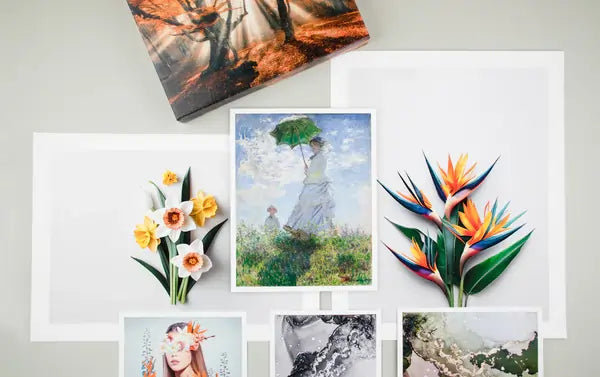There is no single correct number of print sizes to sell. Some artists prefer offering one signature size, while others provide several. Whether you include the original artwork size or adjust for common framing formats depends on your goals and production process.
When deciding how many sizes to offer, think about these factors:
- Shipping – larger prints cost more to pack and ship safely.
- Cost – different materials and papers affect pricing and margins.
- File parameters – resolution and aspect ratio may limit the largest usable size.
Balancing these details helps you create a product line that works for your workflow, your customers, and your bottom line.
Common Print Sizes
Popular print sizes include 8x10, 11x14, and 16x20 inches. These standard U.S. sizes fit readily available frames and mats. If your artwork does not match these proportions, you can add borders or crop slightly to fit.
Offering two to four sizes that align with your artwork’s aspect ratio keeps things simple and helps customers find the right fit for their space. These sizes can range from mini prints to large statement pieces.
- Wide range: 4x4, 6x6, 12x12, 20x20, 30x30
- Medium range: 6x8, 12x16, 18x24
- Small range: 4x6, 5x7, 6x9
The Stackhouse Printery frequently prints smaller formats like 4x4, 4x6, and 5x7 for artists who sell in-person or online. Larger formats such as 18x24, 20x30, and 24x36 are also common for gallery or wall art collections.
How to Match Aspect Ratios
To match your print sizes, measure the artwork or check your digital file’s pixel dimensions. Divide the longer side by the shorter side to find the ratio, then choose print sizes that share that ratio.
Use the chart below to find standard sizes that align with each aspect ratio, or read our aspect ratio guide for a detailed explanation.
| Aspect Ratio | Matching Sizes (inches) |
|---|---|
| 1:1 | 4x4, 5x5, 6x6, 8x8, 10x10, 12x12, 16x16, 20x20, 24x24, 30x30 |
| 2:3 | 4x6, 6x9, 8x12, 10x15, 12x18, 16x24, 20x30, 24x36, 40x60 |
| 3:4 | 6x8, 9x12, 12x16, 18x24, 30x40 |
| 4:5 | 8x10, 11x14, 16x20, 24x30 |
| 5:7 | 5x7, 10x14 |
Other common yet unique ratios include 7x10, 8.5x11, 11x17, 13x19, and 14x18. Sticking to consistent ratios helps you avoid extra cropping or formatting later.
Tips for Selling Multiple Sizes
Once you know your ratios and pricing, offering several size options can attract a wider range of customers. Keep these best practices in mind:
- Start with easy-to-ship formats like loose prints or mini prints to minimize handling time and shipping fees.
- Know your audience. Too many choices can be overwhelming; a focused selection feels curated and professional.
- Smaller prints such as Mini Prints are often more affordable and sell in higher quantities.
- Larger prints carry higher perceived value but require more packaging and shipping costs.
To learn more about size options, borders, and layout tips, visit our Print Size and Border Guide.
Final Thoughts
The best number of sizes to offer depends on your audience, your workflow, and how your art translates across formats. A mix of two to four sizes often works best, giving buyers flexibility while keeping production manageable.
Ready to plan your print lineup? Explore pricing and size options, and start creating prints your audience will love.









